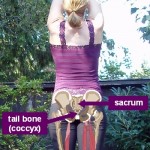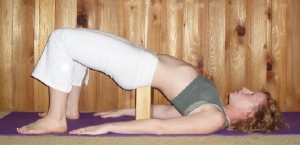I picked up this variation on setu bandhasana in a restorative yoga class I attended in San Francisco a while back. Before you get started, you have to figure out where your sacrum is. Your sacrum is the part of your spine that acts as the posterior (back) wall of your pelvis. The spine is made up of bones called vertebrae that are stacked one on top of the other, but in the sacrum these bones become fused. So, if you feel down your spine in the low back, you’ll feel the bump of each vertebra, but when you get to the sacrum (in the back of the pelvis), the bumps will become much less pronounced. The very end of the spine, just inferior to (below) the sacrum is the coccyx, or tail bone.
The instructions for this posture are pretty simple. Make your way into setu bandhasana (bridge pose), and then slide a block under the sacrum. Make sure that the block isn’t underneath the low back or tail bone, these areas are not as stable as the sacrum. Remember that yoga blocks can have three different heights, depending on which side you put them on, to accommodate different levels of flexibility. Make sure you put the block in the best orientation for your body. The low back is susceptible to injury, so you do have to be careful here. Avoid getting in the habit of sustaining pain in the low back. Even if you don’t get injured during your yoga practice itself, you will carry this habit into the rest of your life where there are less controlled situations, and the chance for injury is much greater.
If you feel comfortable in this posture there is another variation you can take: lengthen out the legs, placing the feet closer to the end of your mat. You may need to readjust the block to make it more comfortable. This deepens the bend in the low back, so make sure you return to the previous variation or change the orientation of the block if you feel any discomfort. If you want to add a little more length, extend the arms in the opposite direction, reaching out past the top of your mat.
This pose improves flexibility in the spine, and stretches the hip flexors (muscles in the front of the hip) and abdominals (stomach muscles).


